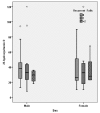The association between serum 25-hydroxyvitamin D level and recurrent falls in the elderly population: a cohort study
- PMID: 27757178
- PMCID: PMC5053449
- DOI: 10.19082/2707
The association between serum 25-hydroxyvitamin D level and recurrent falls in the elderly population: a cohort study
Abstract
Introduction: Serum vitamin D concentration is a major contributing factor for increasing the risk of fall and fall-related injuries in older adults. However, when prescribed and supplemented for these populations, the outcomes are controversial, and in several cases no improvement has been reported in reducing the risk of recurrent falls. This study aimed to examine the association between serum vitamin D concentration and recurrent falls in Iranian older adults.
Methods: This cohort study was conducted in the emergency departments of two university hospitals. A cohort of 82 elderly participants aged over 60 and suffered from an unintentional episode of falling was evaluated six months after their first ED visit. A structured, self-administered checklist was developed to obtain the participants' demographic and clinical information. Participants also were asked about any recurrent fall experience during follow-up.
Results: The mean (SD) age of the study population was 75 (8). Over half of the participants were male (57.3%). The mean (median) serum 25-hydroxyvitamin D (25 (OH)D) concentration was 38 (34) ng/ml. Mean serum 25(OH)D levels varied slightly between gender groups (p=0.450). An inverse but insignificant association was found between the age of participants and their serum 25(OH)D levels (r=-0.03, p=0.7). A small but insignificant association also was found between the mean serum 25(OH)D level and the number of recurrent falls in elderly patients irrespective of their age, gender, or physical activity groups (OR=1.008, p=0.992).
Conclusion: In contrast to previous studies, no significant association of serum 25(OH)D concentration was found with recurrent falls in Iranian older adults.
Keywords: 25-hydroxyvitamin D; Elderly; Iran; Vitamin D insufficiency; falls.
Conflict of interest statement
There is no conflict of interest to be declared.
Figures
Similar articles
-
Serum 25-hydroxyvitamin D level and risk of falls in Japanese community-dwelling elderly women: a 1-year follow-up study.Osteoporos Int. 2015 Aug;26(8):2185-92. doi: 10.1007/s00198-015-3130-1. Epub 2015 Apr 25. Osteoporos Int. 2015. PMID: 25910748
-
[Frontiers in vitamin D; basic research and clinical application. Vitamin D and falls].Clin Calcium. 2011 Nov;21(11):71-9. Clin Calcium. 2011. PMID: 22040823 Review. Japanese.
-
Low serum 25-hydroxyvitamin D levels associated with falls among Japanese community-dwelling elderly.J Bone Miner Res. 2008 Aug;23(8):1309-17. doi: 10.1359/jbmr.080328. J Bone Miner Res. 2008. PMID: 18410227
-
Interventions to Prevent Falls in Community-Dwelling Older Adults: A Systematic Review for the U.S. Preventive Services Task Force [Internet].Rockville (MD): Agency for Healthcare Research and Quality (US); 2018 Apr. Report No.: 17-05232-EF-1. Rockville (MD): Agency for Healthcare Research and Quality (US); 2018 Apr. Report No.: 17-05232-EF-1. PMID: 30234932 Free Books & Documents. Review.
-
Questioning vitamin D status of elderly fallers and nonfallers: a meta-analysis to address a 'forgotten step'.J Intern Med. 2015 Jan;277(1):16-44. doi: 10.1111/joim.12250. Epub 2014 May 23. J Intern Med. 2015. PMID: 24697944 Review.
Cited by
-
Vitamin D and Hospital Admission in Older Adults: A Prospective Association.Nutrients. 2021 Feb 14;13(2):616. doi: 10.3390/nu13020616. Nutrients. 2021. PMID: 33672800 Free PMC article.
References
-
- World Health organization. Falls. World Health Organization; 2012.
LinkOut - more resources
Full Text Sources
Other Literature Sources

